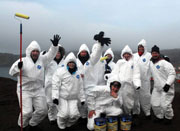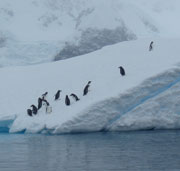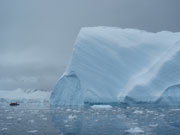Julia Ivanov from AkzoNobel Surface Chemistry discovered that sustainability and leadership go hand in hand with adventure in Antarctica. She shares her experiences from the Leadership on the Edge (LOTE) programme and explains how she is translating them at work
Sustainability is a term that is constantly bandied about these days. But in reality, what does it mean? In the words of former Norwegian Prime Minister Gro Harlem Brundtland, sustainability is “meeting the needs of the present without compromising the ability of future generations to meet their needs”. For AkzoNobel, a major producer of speciality chemicals and paints and coatings that employs approximately 60,000 people in 80 countries, that general statement is being translated into the simultaneous and ethical pursuit of three major objectives:
• Delivering profitable economic growth
• Lowering the environmental footprint around the world
• Developing the talent of its personnel to the fullest.
The first objective is what any knowledgeable company would want to achieve. But how to do it while achieving the other two objectives, thus ensuring sustainability in the commercial arena? For me the quest to answer that question began the day I learned I was to be one of 12 employees from AkzoNobel sites around the world selected to participate in the Leadership on the Edge (LOTE) programme.
The LOTE programme was created by Robert Swan OBE, legendary polar explorer and environmentalist, to promote leadership and sustainability through inspiration and adventure. As a supporter of this programme AkzoNobel seeks to invest in each participant’s journey to self-leadership and self-awareness with the understanding that true leadership starts from within. The programme underlines the company’s commitment to sustainability by encouraging the participants to become ambassadors and inspire their colleagues to incorporate sustainable business practices into their work and everyday lives.
As for adventure there would be no environment more challenging than the one we would face for nearly two weeks in March 2009: Antarctica.
Antarctica is the highest, driest, coldest and windiest continent on earth, with an average annual temperature of -50ºC. It contains 70% of the world’s freshwater and 90% of the world’s ice and is home to many species of penguin. And its landmass is mammoth – 14m km2 – which is twice the size of Australia.
And in terms of inspiration, there would be nobody more motivating than the leader of the expedition. Robert Swan was the first man to walk unassisted to both the North Pole and the South Pole and has dedicated his life to the preservation of Antarctica by promoting recyling, renewable energy and sustainability to combat the effects of climate change. In addition, he founded the 2041 organisation, so named because the year 2041 is the date that the Madrid Protocol, part of the legislation designed to protect Antarctica as a natural reserve, comes up for review. The organisation’s mission is to inform, engage and inspire the next generation of leaders to take responsibility, to be sustainable and to recognise that now is the time for action in policy development, business generation and future technologies. Swan also began leading corporate expeditions to Antarctica in 2003.
AkzoNobel’s 2009 Mission Antarctica leadership team gathered on 14 March at a hotel in the city of Ushuaia in southern Argentina to begin this exciting expedition. We met Swan and his colleagues from the 2041 organisation. We also met a number of other participants from a wide variety of groups, including Coca Cola and Hewlett-Packard. In all, we were 71-strong from 28 nations.

The AkzoNobel group, ready to paint E-base on King George Island
Even within our own group, we had diverse nationalities, backgrounds and age levels, which meant we were not all going to think the same way and could look at a subject from different sides. For myself, I was born in Kazakhstan and moved with my family to Germany when I was 14 years old. I currently work as a senior technical service chemist in the global personal care division of AkzoNobel’s surface chemistry business unit in Sempach Station, Switzerland, so I didn’t find the diversity of nationality and language intimidating. I was also one of the youngest.
The next day we were given the opportunity to meet the individuals from the other groups as well as get an indication of the extreme conditions we would be facing in Antarctica. Participants were divided into eight groups (the AkzoNobel team was also divided) and we proceeded to hike the Glaciar Martial Mountains, which reach to heights of approximately 10km. Three members of the AkzoNobel team were selected as group leaders for the hike. The purpose of the hike was to enable us to meet new people and feel part of a team as well as get a feel for our outerwear and gear in extreme conditions.
Following the hike, everyone introduced themselves, with each of us given 90 seconds to identify ourselves and say why we had come and what we hoped to gain from the expedition.
And they’re off
On 17 March, following a discussion of safety and the precautionary measures to take while on board, we set sail for Antarctica aboard the expedition vessel Ioffe which would be our home for the next ten days. The first two days were taken up by our voyage to the continent, which took us south to Cape Horn and then through the Drake Passage, a stretch of ocean notorious for its rough seas and mountainous waves.
Fortunately, the Drake Passage was relatively placid, which unfortunately didn’t stop many of us from being seasick. But we made sure we looked out for each other. If one couldn’t leave their room for meals, someone would bring them food or medicine if it helped. Looking out for each other was stressed by Swan in a presentation on board as well as mandatory adherence to the ‘Bronco 5 rule’, which stipulated that everyone had to meet up no less than five minutes before all meetings or excursions were scheduled to start. Come late and you could expect to be left behind.
Our safety coordinator held a briefing with everyone to go over safety and environmental issues regarding the wildlife we might encounter and to remind us to try not to step on sensitive grasses and plant life. He also stressed the importance of first looking out for ourselves and then being ready to help others, advice that we heeded throughout the entire expedition.
Waking Up to Antarctica
On 18 March, we woke up to find ourselves in Antarctic waters, approaching the South Shetland Islands. From there, we headed towards King George Island. Following a briefing on how to navigate Zodiacs, the small inflatable boats that would be our transportation to and from the ship, we headed ashore for King George Island and the Russian base, Bellingshausen. From there it was a short excursion to the E-base, an education station built by Swan and several colleagues out of recycled material to show people just how fragile the environment is and to inspire them to take action to preserve Antarctica.
Inaugurated in 2007, E-base is powered by the sun and wind which in turn operate all the equipment required to sustain day-to-day survival. E-base functions as a comms centre capable of broadcasting audio, video and text via satellite over the internet. In March 2008, Swan and a small advanced party lived in and around the completed E-base for two weeks, tracking the amount of energy they used, broadcasting their daily activities over the internet and documenting how they sustained their day-to-day existence. They were subsequently joined by an 80-member expedition, 12 of whom were members of the first AkzoNobel Mission Antarctica team.
Our initial visit was brief and we dropped off the paint supplied by AkzoNobel for repainting the E-base. The next day we returned to the E-base, donned painter’s whites and set about painting both the interior and exterior of the base. Following our painting project, we went for a three-hour hike through land formed by a series of erupting volcanoes, intent on observing a nearby glacier.
That evening we participated in a seminar conducted by Swan on leadership. With his own life story of exploration and survival as the text, he conveyed key messages that we would work on for the remainder of our stay, notably control what you can control, manage with patience, manage through delegation.
Far from being a holiday in an exotic venue, the expedition was a full learning programme from morning to evening. Typical waking hours stretched from 8am to 10pm, during which we partook in educational excursions and hikes, supplemented with presentations by Swan and various experts on sustainability and climate change. After the presentations, we gathered in leadership workshops to review and discuss these topics. We also watched films on climate change. Of course we took every opportunity to explore the wildlife indigenous to this frozen continent. For example, cruising in our Zodiacs in a bay skirted with different ice formations, we came upon a zoologist’s delight that included a penguin colony, fur seals and humpback and minke whales.
One night proved particularly memorable. Members of the expedition willing to brave a full night spent not on the ship but on the Antarctic ice were divided into teams of up to six people, each team led by a designated camping captain. We headed to a spot at the foot of a glacier surrounded by a bay and enclosed by mountains. Everyone pitched in to set up the tents. Half of the overnight campers decided to spend the night outside the tents so shelters were created by digging down into the ice and building small walls to protect against the freezing wind. As this was the first camping trip in my life and the temperature was exceedingly cold, I opted for a tent. This didn’t help me sleep though, the groans from the mountains caused by shifting glaciers keeping me awake.

Penguins take a break from the freezing waters of Wilhelmina Bay
The next morning we returned to the ship for a much needed hot shower and breakfast, then spent time reflecting on our experience, and catching up on a bit of sleep if necessary.
One evening, we formed break-out groups from the entire expedition to discuss and share our observations and feelings about what we had experienced in this most challenging environment. While each group brought together several nationalities, cultures and backgrounds, it soon became clear that the impact of this beautiful continent was universal.
Our final trip in the Zodiacs took us to the little islands close to the end of the 1,600 metre Lemaire Channel, one of the most spectacular places on the Antarctic coast. Here, even in the midst of a formidable collision of falling snow, rain and hail bolstered by a strong wind, we saw a clear example of the power that natural water can unleash. Huge rocks had been broken down into pieces by the seasonal changes of streaming water to ice and vice versa. After enduring about 20 minutes of buffeting by increasingly intense hail and wind, we were called back to the ship.
Taking responsibility
Back on board, we listened to a final lecture by Swan, who once again asked each of us to acknowledge our responsibility to take the necessary actions to ensure the future welfare of our world, stressing that it is up to everyone to switch to renewable energy if we want to minimise the effects of climate change.
On our two-day journey back to Ushuaia, we were able to appreciate why the Drake Passage is considered one of the roughest stretches of sea in the world. On the first night (25 March), the ship was rocked by waves as high as ten metres and pounded by 60 knot winds. Of the 90 people on board, only 32 felt well enough to go to dinner, the others remaining anchored to their beds, grateful for the bread and crackers their cabin mates brought them to calm their digestive systems. The second day brought improved weather conditions, with waves reduced to a more reasonable six metres and the wind speed to 40 knots. This respite enabled the AkzoNobel team to meet with Swan one final time to discuss leadership, climate change and sustainability before returning to Ushuaia.
We spent the final day at our hotel discussing the expedition and what it would mean to us in terms of leadership, climate change and future intentions. We discussed our vision as a team and as individuals, with conversations leading to discussions of stakeholders that we should strive to influence. We began work on presentations for AkzoNobel employees and external groups, fully aware that we aimed to communicate with a wide range of people. And we voiced our appreciation to each other for the values we embraced and shared as a team. The passion and desire we were consumed by to aid AkzoNobel in its pursuit of sustainability and to make the world in general a better place made this experience second to none.
Lessons of Antarctica
In the months following our mission to Antarctica, each of the 2009 Mission Antarctica team members has endeavoured to implement the principles of leadership and sustainability that were presented and discussed by Swan and his colleagues from the 2041 organisation – principles whose importance and urgency were accentuated by our unforgettable expedition to that most beautiful, awe inspiring and extremely challenging continent of Antarctica.
To say the expedition was a learning experience is about as dramatic an understatement as you could make. From Swan, I learned that great leaders are first and foremost great human beings, people who inspire others by their actions. They are strong, passionate and devoted people who put their words into actions that will make a significant difference, but who themelves remain humble.
I also learned that it was essential to first achieve self-leadership through honest self-awareness. From that critical first step forward came an appreciation of the importance of accepting the need to control what you can and to take on leadership responsibilities with the full knowledge that assuming someone else would do this is not an option. In the words of Swan: “The greatest threat to our planet is the belief that someone else will save it.”

Incredible, unforgettable views from a tiny Zodiac
For each member of the expedition, we could start by calculating our own carbon footprint and taking the necessary actions to reduce it. The ecological footprint is a measure of human demand on the earth’s ecosystems, comparing human demand with the planet’s ecological capacity to regenerate. It is the amount of land and sea area needed to regenerate the resources that the human population consumes and to absorb and render harmless the corresponding waste that it produces.
Once I returned home, I set about reducing my carbon footprint, which I had calculated to be 10.80 tonnes a year. If I continued to live as I had, I would have needed over two and a half planets to sustain me, not just the one we have. Starting simply, putting my own house in order first, I resolved to make my apartment energy efficient by, among other things, using energy saving light bulbs and energy efficient appliances, as well as sorting household garbage – glassware, paper, metal, compost, batteries – into different bins made for more efficient, environmentally friendly disposal. And I have modified my personal behavior – shutting off appliances completely instead of leaving them on standby, switching off lights in rooms not in use, avoiding products with lots of packaging.
But how to reduce the carbon footprint of an entire global company?
For my sustainable business project, titled CO2ntrol, I have been working to determine the carbon footprint of the global personal care division of AkzoNobel’s surface chemistry business unit. My specific objective is to seek more sustainable and cost effective ways to travel or alternatives to travel such as videoconferencing, then compare their effects to the current situation in terms of cost, carbon dioxide emissions, working time, customer focus, convenience and footprint. Through this project, I hope to raise awareness of the need for more environmentally conscious and sustainable travel management while also reducing costs, gaining convenience and retaining customer focus.
The overall aim is to help create a sustainable culture in the personal care division – a contribution I hope will be one step forward among many to create a sustainable culture everywhere that AkzoNobel calls home.
Author
Julia Ivanov
Senior technical service chemist – global personal care division, AkzoNobel Surface Chemistry
www.akzonobel.com/personalcare



